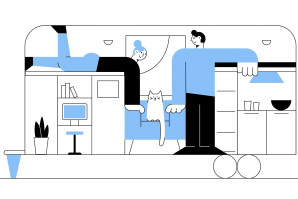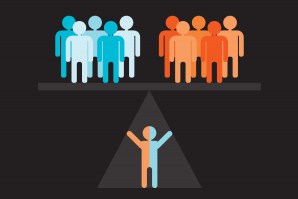The U.S. affordable housing crisis is in a critical state. Thanks to ballooning housing prices, higher interest rates and limited housing stock, finding a home that’s reasonably priced is as challenging as it’s been in decades.
In recent months, there has been much policy debate around solutions to these issues. Much of it has centered around reducing barriers to viable housing through a process called upzoning. This would allow developers greater freedom in their efforts to boost housing density, particularly near bus, light rail and other transportation options.
Many housing advocates point to the benefits of this, the biggest of which is greater flexibility when it comes to adding home additions for older relatives, kids who are bluebirding after college and nomadic short-term renters.
Washington, D.C., based architect Ileana Schinder is a relentless advocate for residential and urban design solutions that can offer pathways for addressing today’s pernicious affordable housing crisis. She highlights these in her book “Housing for Humans: A Book to Imagine, Create and Design a New Housing Model in America.”
Schinder opines that housing scarcity magnifies inequalities, as less affluent Americans find themselves mired in an untenable homeownership narrative. Much of this, she says, is due to rising prices and the inability to boost their savings due to high rental housing costs.
Her book asserts that the affordable housing crisis can be addressed through creative approaches to residential and urban design. She says that what we are facing now is nothing new, pointing out that societies historically have had to reframe the role of cities to better meet the existing realities around housing demand.
With an eye towards first-time homeowners, retirees and those who are location independent, the book explores a fresh set of housing approaches, such as additional dwelling units that can be implemented in dense center cities as well as suburbs.
Another housing affordability factor she addresses is the rising demand for remote work options, which has led to a growing number of Americans seeking housing options that allow for dedicated office space. Many, says Schinder, are thus looking to upgrade from single-family dwellings to those that accommodate a home office.
Schinder’s book makes a strong case for the design and use of additional dwelling units, a solution she believes is pivotal during a time of aging parents, boomerang kids and even the needs of homeowners themselves to defray mortgage or rental housing costs.
“Access to affordable housing is not just about putting people in buildings. The current crisis in affordable housing and the ongoing deficit of dwelling units in cities and suburbs highlight the need to re-evaluate the use of private spaces.”Ileana Schinder, architect and author
This movement toward accessory housing options, she adds, has picked up a lot of momentum in the past year or so.
“Say you have a backyard,” Schinder says. “One option is to create a secondary home within your property. In other words, instead of having to go to the suburbs or the exurbs to find an empty lot and build a new house, you can develop an additional housing unit on the lot you already have. So instead of having just a single family home and one house on a lot, you can have two or more depending on the zoning of where you are.”
According to Schinder, while accessory dwellings have existed for centuries, the concept has only recently started to gain attention in the U.S. She adds that most media articles on ADUs “have a rarity to the, as in ‘look what I did’ instead of ‘everyone else is doing the same.’”
“If you think about it, everywhere in the world you have shops below and houses on top; you have houses where you enter a door and there are separate spaces and units,” Schinder says. “So it’s a simple idea, the fact that neighborhoods can accommodate more than one house per lot.” Nevertheless, she believes that ADUs will lead to major changes in the real estate industry within five to 10 years
Schinder’s book also offers thoughts on what is known as “The Airbnb Effect,” where residential properties owners enter into short-term rental agreements with tourists, traveling nurses or other occupants. She argues that these arrangements, in addition to creating an upsurge in retail housing prices, have the effect of removing housing stock that would be otherwise available to families or long term residents.
In the end, by advocating for a creative and strategic approach to the new realities around affordable housing, Schindler hopes to ignite much-needed dialogue around viable options to America’s prohibitively expensive housing market.
“My hope is that ‘Housing for Humans’ will make a valuable contribution to the discussion of affordable housing by widening the conversation on the types of housing we are willing to explore,” she says. “Ultimately, I am advocating for the creation of better and more housing by transforming garages, basements and other underutilized spaces into valuable housing options through the better use of existing neighborhoods and public infrastructure.”
Recommended For You

Book Review: ‘Housing for Humans’
An architect advocates for creative, simple solutions to the affordable housing crisis
Washington, D.C., based architect Ileana Schinder is a relentless advocate for residential and urban design solutions that can offer pathways for addressing today’s pernicious affordable housing crisis. She highlights these in her book “Housing for Humans: A Book to Imagine, Create and Design a New Housing Model in America.”

Book Review: ‘The Art of Badassery: Unleash Your Mojo With Wisdom of the Dojo’
A martial artist and health coach helps women apply dojo discipline to personal life and business
Whether the opponent is an overbearing boss, financial hardship or a testy love relationship, Jennifer Cassetta shows readers how to create a roadmap for ascending beyond one’s fears, turning challenges and setbacks into superpowers.

Book Review: The Nature of the Tribe
Tribal Leadership: Leveraging Natural Groups to Build a Thriving Organization
We live in a world of tribes. On a macro level, we discover that every organization is a tribe, a cadre of people involved in formal and informal levels of engagement. The existence of these tribes has major implications for today’s leaders in their quest to create world-class teams, businesses and companies that make a difference.

Book Review: Hard-Hitting Consulting How-To
‘Million Dollar Consulting: The Professional's Guide To Growing A Practice’ is not for the faint of heart
So-called expert consultants abound, but Alan Weiss’ Million Dollar Consulting: A Professional Guide To Building A Practice offers what many other how-tos don’t: modern, actionable tools for building a highly profitable enterprise.

Book Review: The Business of Time, Money and Significance
‘Making Money Is Killing Your Business' asks us to rethink how we define success
Time, money and significance: These are the three desires that every entrepreneur strives for in a business. Unfortunately, most find themselves caught in the never-ending pursuit of money, squelching the essence of true business ownership and personal freedom. As a result, the enterprise never delivers time back for the things we enjoy doing or the opportunity to make a significant impact on the world around us.

Book Review: ‘Blockchain Revolution’ Examines Impacts of Bitcoin
AirBNB, Deloitte, IBM among business leaders using blockchain technology
Blockchain Revolution delivers an informed look at the transformative influence of this technology on the evolving political, economic and social world order.



